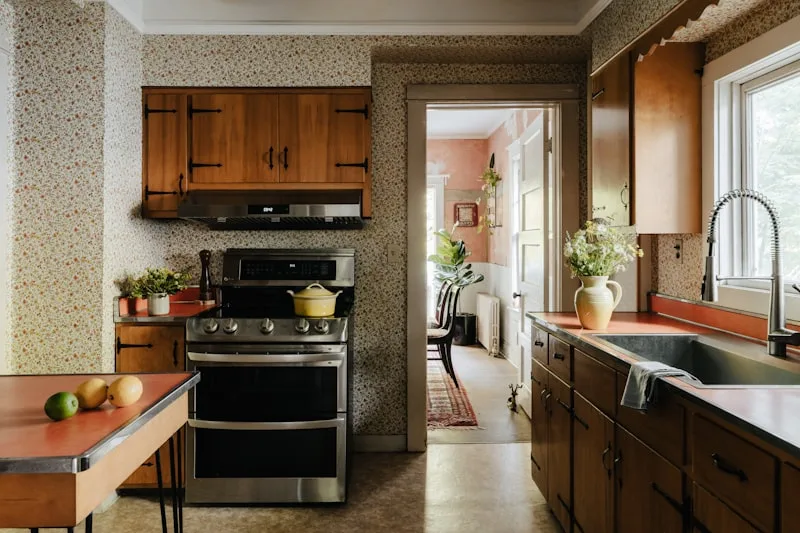First off, let’s talk about the food factor. Kitchens are treasure troves of delicious morsels, and those soffits often catch the crumbs that fall during cooking or snacking. Mice are savvy little creatures; they know where to find a feast. Plus, the height of soffits gives them a perfect vantage point to scout for food without being easily spotted. It’s like having a front-row seat to the buffet!
But it’s not just about the food. Soffits provide a warm, sheltered environment that’s perfect for nesting. Mice are all about finding safe spots to raise their families, and those nooks above cabinets offer protection from predators. It’s like a cozy little apartment where they can settle down and feel secure.
And let’s not forget about the access points. Mice are expert climbers and can easily scurry up cabinets to reach those hidden spaces. If there’s even the tiniest gap, they’ll find a way in. It’s like a secret entrance to their little kingdom!
So, if you’ve ever spotted a mouse darting around your kitchen, it’s likely they’re just trying to make themselves at home in that perfect little spot above your cabinets. Who wouldn’t want a cozy hideaway filled with snacks?
Soffits and Snacks: Unraveling the Mystery of Mice’s Kitchen Hideouts
Soffits are those horizontal panels that bridge the gap between your cabinets and the ceiling. They might look innocent, but they can be a mouse’s secret lair. Think of them as a high-rise apartment for rodents, complete with easy access to your food stash. Mice are crafty little creatures, and they can squeeze through the tiniest of openings. If there’s even a small crack or gap in your soffit, it’s an open invitation for them to move in.

Now, let’s talk about snacks. Mice are opportunistic eaters, and your kitchen is a buffet of delicious options. From crumbs left behind after a late-night snack to pet food left out, they’ll take advantage of any food source. If they find a way into your soffits, they can feast on all those tasty morsels without you even knowing. It’s like having a secret dinner party that you didn’t invite them to!
So, what can you do to keep these little invaders at bay? Start by sealing up any gaps in your soffits and keeping your kitchen clean. Regularly check for signs of mice, like droppings or gnaw marks. Remember, a clean kitchen is a less inviting place for these furry intruders. By taking a few simple steps, you can reclaim your kitchen and keep those mice from turning your soffits into their personal snack bar!
The Soffit Secret: Why Your Kitchen Cabinets Are a Mouse Magnet
First off, let’s talk about soffits. These are the horizontal panels that sit above your cabinets, often housing ductwork or plumbing. They might seem innocuous, but they can be a hidden haven for mice. Think of soffits as the cozy attic of your kitchen—dark, warm, and full of nooks and crannies. Mice are like tiny explorers, always on the lookout for a safe place to nest, and those little spaces in your soffits can feel like a five-star hotel to them.
Now, consider this: if your soffits have gaps or cracks, it’s like leaving the front door wide open. Mice can squeeze through openings as small as a dime! Once they’re in, they can easily access your cabinets, searching for crumbs or food. And let’s be honest, who hasn’t dropped a few morsels while cooking? Those little bits can be a feast for our furry friends.
Moreover, if your kitchen is cluttered or poorly organized, it creates even more hiding spots. Imagine a maze of boxes and jars—mice love that! They can scurry around unnoticed, making themselves right at home. So, keeping your kitchen tidy isn’t just about aesthetics; it’s a crucial step in mouse prevention.
In essence, your kitchen cabinets might be a mouse magnet because of those unassuming soffits. By sealing gaps and maintaining a clean space, you can turn your kitchen from a rodent paradise into a mouse-free zone. Who knew that a little attention to detail could make such a big difference?
Above the Cabinets: Exploring Mice’s Favorite Cozy Nook in Your Kitchen
Imagine this: a warm, dark space, tucked away from prying eyes, with easy access to crumbs and food particles. It’s like a buffet for mice! They love to scurry up there, making themselves at home among the dust bunnies and forgotten holiday decorations. And let’s be honest, who wouldn’t want a little hideaway where they can munch on leftover snacks without a care in the world?
But why do they choose this particular spot? Well, it’s all about safety and comfort. Above the cabinets, they’re shielded from predators and can nestle in the insulation of your home. It’s like having a penthouse suite with a view—if only they could appreciate the décor! Plus, the warmth from your kitchen appliances creates a snug environment, perfect for raising a family of little mice.
Now, you might be wondering how to keep these uninvited guests from turning your kitchen into their playground. Regular cleaning is key! Dusting off those cabinets not only keeps your kitchen looking sharp but also helps you spot any signs of a mouse invasion. And don’t forget to seal up any gaps or holes where they might sneak in. Think of it as fortifying your castle against tiny invaders.

So, next time you’re in the kitchen, take a moment to look up. You might just be surprised at what’s lurking above your cabinets!
Soffits: The Unseen Highway for Mice in Search of Food and Shelter
Soffits are the horizontal surfaces that connect the roof overhang to the exterior walls of your home. They’re designed to ventilate your attic and keep moisture at bay, but they also create a perfect entry point for mice. Just like a welcome mat, they invite these little invaders to come in and make themselves at home. Mice are crafty creatures, and they can squeeze through the tiniest gaps—think of them as the Houdinis of the animal world. If your soffits have any cracks or holes, it’s like leaving the front door wide open.
Once inside, mice can find warmth, safety, and, of course, food. They’re not picky eaters; a crumb here and a leftover there can turn your attic into a gourmet restaurant for them. And let’s be honest, who wants to share their home with uninvited guests? The thought of little paws scurrying around while you’re trying to relax is enough to make anyone shudder.
Frequently Asked Questions
Why Are Soffits Above Kitchen Cabinets Attractive to Mice?
Soffits above kitchen cabinets can attract mice due to their enclosed spaces, which provide ideal nesting sites and shelter. These areas often contain food particles and moisture, making them appealing for rodents seeking food and a safe environment. Regular cleaning and sealing gaps can help deter mice from these areas.
Are Soffits Above Cabinets a Common Problem for Homeowners?
Soffits above cabinets can be a common issue for homeowners, often leading to design challenges and maintenance concerns. They may create a gap that collects dust and can limit storage options. Homeowners frequently consider removing or modifying soffits to enhance aesthetics and functionality in their kitchens.
What Signs Indicate Mice Are Living in My Kitchen Soffits?
Look for droppings, gnaw marks, and nesting materials in your kitchen soffits. Unusual sounds, such as scratching or scurrying, especially at night, can also indicate their presence. Additionally, check for grease marks along surfaces and entry points, as these can signal frequent mouse activity.
What Makes Soffits a Common Nesting Spot for Mice?
Soffits provide sheltered, elevated spaces that are often undisturbed, making them attractive nesting sites for mice. The enclosed areas offer protection from predators and harsh weather, while the proximity to food sources, such as attics or kitchens, enhances their appeal. Additionally, gaps or openings in soffits can serve as easy entry points for mice seeking a safe place to build their nests.
How Can I Prevent Mice from Entering My Kitchen Soffits?
To prevent mice from entering kitchen soffits, seal any gaps or cracks with caulk or steel wool, install tight-fitting screens over vents, and ensure that all food is stored in airtight containers. Regularly inspect and maintain the area to eliminate potential entry points and nesting sites.
